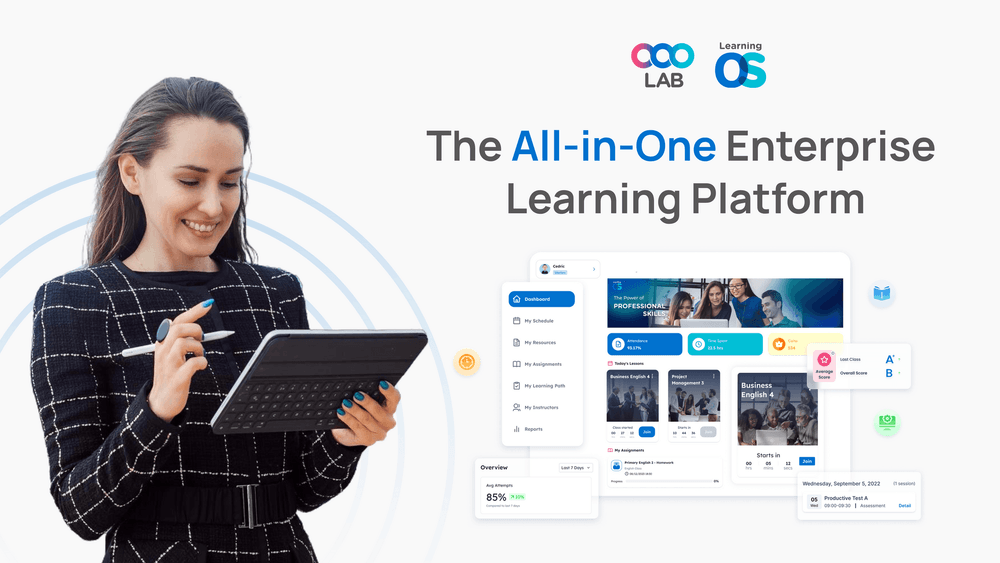Investing in an Enterprise LMS (Learning Management System) is a strategic decision to empower your workforce, streamline training, and drive organizational success. Whether delivering compliance courses or specialized programs like sales training, these platforms promise significant benefits. However, to justify the investment and optimize its impact, organizations must measure the return on investment (ROI). Calculating ROI ensures that your Enterprise LMS delivers tangible value, aligning training with business goals.
This blog explores how to measure ROI from an Enterprise LMS, offering practical steps, key metrics, and real-world insights. Backed by data, we’ll guide you through quantifying financial and non-financial returns to demonstrate the true impact of your learning initiatives.

I. Why Measuring ROI for an Enterprise LMS Matters
An Enterprise LMS is a powerful tool for large organizations, enabling scalable, personalized training across diverse teams. From upskilling employees to delivering sales training, it supports continuous learning and operational efficiency. However, implementation and maintenance involve significant costs—licensing, content development, and ongoing support. Measuring ROI validates these expenses and provides insights for improvement.
According to a 2024 Brandon Hall Group study, 68% of organizations struggle to quantify training ROI, risking misaligned investments. By calculating ROI, you can:
Justify Costs: Prove the LMS’s value to stakeholders.
Optimize Training: Identify what works and refine underperforming programs.
Align with Goals: Ensure training drives business outcomes, like revenue growth from sales training.
Understanding ROI transforms your Enterprise LMS from a cost center into a strategic asset.
>>> Read more: What is an Enterprise LMS
>>> Read more: Customization Options for Enterprise LMS
II. Understanding ROI in the Context of an Enterprise LMS
ROI measures the financial return of an investment relative to its cost, typically expressed as a percentage:
ROI (%) = [(Gain from Investment – Cost of Investment) / Cost of Investment] × 100
For an Enterprise LMS, “gain” includes both tangible benefits (e.g., cost savings, revenue growth) and intangible ones (e.g., employee satisfaction, productivity). Costs encompass licensing, implementation, content creation, and maintenance.
Calculating LMS ROI is complex because benefits span multiple areas—training efficiency, performance, and compliance. For example, sales training delivered via an LMS might increase close rates, contributing to revenue. Non-financial gains, like reduced turnover, also matter but require careful quantification.
>>> Read more: Common challenges when implementing an Enterprise LMS
>>> Read more: Steps to implement an Enterprise LMS
>>> Read more: Enterprise LMS - revolutionizing corporate training and development
Book Free Demo with us. Bring your Training and Learning to a new height with LearningOS.

III. Steps to Measure Enterprise LMS ROI
Measuring ROI requires a structured approach. Below are actionable steps to quantify the value of your Enterprise LMS and ensure accurate results.
1. Define Clear Objectives and KPIs
Start by aligning LMS goals with business priorities. Are you aiming to reduce training costs, improve sales performance, or ensure compliance? Define specific, measurable key performance indicators (KPIs) to track progress. Common KPIs include:
Training Efficiency: Time and cost savings from streamlined delivery.
Performance Improvement: Metrics like sales revenue or customer satisfaction post-sales training.
Compliance Rates: Percentage of employees completing mandatory courses.
Employee Engagement: Course completion rates and learner feedback.
Clear objectives ensure ROI calculations focus on what matters most.
2. Calculate Total Costs
Accurate ROI requires a comprehensive view of expenses. Include:
Upfront Costs: LMS licensing, customization, and implementation.
Ongoing Costs: Subscription fees, IT support, and content updates.
Content Development: Time and resources for creating courses, like sales training modules.
Training and Support: Employee onboarding and helpdesk resources.
A 2023 Deloitte report notes that organizations often underestimate ongoing costs, skewing ROI estimates. Track all expenses meticulously to avoid surprises.
3. Quantify Tangible Benefits
Tangible benefits are measurable financial gains. Common examples include:
Cost Savings: Compare LMS training costs to traditional methods (e.g., in-person workshops). For instance, replacing classroom-based sales training with LMS modules can save on travel and venue expenses.
Revenue Growth: Measure performance improvements, like increased sales after sales training.
Time Efficiency: Calculate time saved by automating training delivery and tracking. Reduced onboarding time translates to faster productivity.
Assign dollar values to these benefits for accurate ROI calculations.
4. Assess Intangible Benefits
Intangible benefits, while harder to quantify, significantly impact ROI. Use proxies or benchmarks to estimate their value:
Employee Productivity: Improved skills lead to faster task completion. For example, sales training enhances deal-closing efficiency. Estimate productivity gains based on average salaries and time saved.
Engagement and Retention: Engaged employees are less likely to leave. If turnover drops after LMS implementation, calculate savings using recruitment and onboarding costs.
Customer Satisfaction: Better-trained staff improve service quality. Link customer feedback scores to training initiatives.
Surveys and performance reviews can help quantify these benefits.
5. Use Analytics and Reporting Tools
An Enterprise LMS provides robust analytics to track KPIs. Leverage dashboards to monitor:
Course completion rates and time spent learning.
Quiz scores and skill assessments, especially for sales training.
Compliance certification status.
Compare pre- and post-LMS metrics to measure improvement. For example, if sales close rates rise 10% after sales training, attribute the gain to the LMS.
6. Calculate and Interpret ROI
Plug your data into the ROI formula. For example:
Costs: $100,000 (licensing, implementation, content).
Gains: $150,000 (savings from reduced training costs, revenue from sales training).
ROI: [($150,000 – $100,000) / $100,000] × 100 = 50%.
A positive ROI indicates value, but even a modest percentage can justify investment if intangible benefits are significant. Regularly recalculate ROI to track long-term impact.
7. Communicate Results to Stakeholders
Present findings to leadership using clear visuals, like charts or case studies. Highlight specific wins, such as how sales training increased revenue by 15%. Tie results to business goals to secure ongoing support for the LMS.
IV. Conclusion
Measuring ROI from an Enterprise LMS is essential to validate its value and optimize training initiatives. By defining clear objectives, tracking costs and benefits, and leveraging analytics, organizations can quantify both financial and intangible returns. From cost savings to performance gains in sales training, a well-measured LMS proves its worth as a driver of growth.
As the digital workplace evolves, ROI measurement ensures your Enterprise LMS remains aligned with business goals, delivering lasting impact. Start today by setting KPIs, collecting data, and showcasing results—your investment deserves to shine.
About us
At OOOLAB (pronounced 'uːlæb'), our mission is to make complex learning operations simple. We aim to positively impact the lives of over 1,000,000 learners and educators by the end of 2026.
OOOLAB's LearningOS provides educational institutions and corporate enterprises with an all-in-one solution to create and deliver engaging learning experiences.
We meet organizations' needs or support your growth. We provide undivided attention. We provide:
1. Dedicated success manager: We offer direct communication with a real human who'll discuss your enterprises unique learning operations and goals.
2. Personalized setup: Our team will help you transition to LearningOS on your schedule, one step at a time.
3. Around the clock support: Get help from us any time, and in any time zone.
We have recently launched a new AI training tool, Skill Quotient OS, designed to elevate hybrid training to new heights. It offers role-play exercises with scenarios and assessments.This tool can apply in sales training, corporate development and customer support training in any industry.
Reach out to us at: LinkedIn, Facebook, Instagram, Tiktok, X
FAQ
1. What are the main benefits of LearningOS
Our platform is easy to use and automates all aspects of your learning operations. It efficiently manages complex tasks, allowing you to concentrate on delivering exceptional learning experiences.
2. What main features does LearningOS offer?
Our all-in-one software solution combines a Content Management System, a Learning Management System, content authoring tools, and a mobile friendly Learner Portal.
3. Can your platform be used for corporate enterprises?
Absolutely! LearningOS is an Enterprise LMS is a great fit for corporate learning. In fact, we have clients with up to 700,000 employees using LearningOS! Upskill your workforce by creating and assigning interactive eLearning content while effortlessly tracking employee progress.
4. Who currently uses your platform?
Our platform is currently used by over 120,000+ learners, parents, and employees across 21 countries worldwide!
5. What types of content options are available on your platform?
We offer ready-to-go curriculums for various educational purposes or our expert design team can build a custom course for you. We can also upload your existing learning materials and enhance them digitally.
6. What is unique about LearningOS?
Our platform, designed by educators for educators, provides you with all the tools you need to scale. Build and promote your own hybrid and blended learning courses and save money on licensing fees by owning your own proprietary content.
7. How can I get started?
Schedule a meeting with our experts and we’ll talk about how our platform can address your unique challenges and help to grow your business.